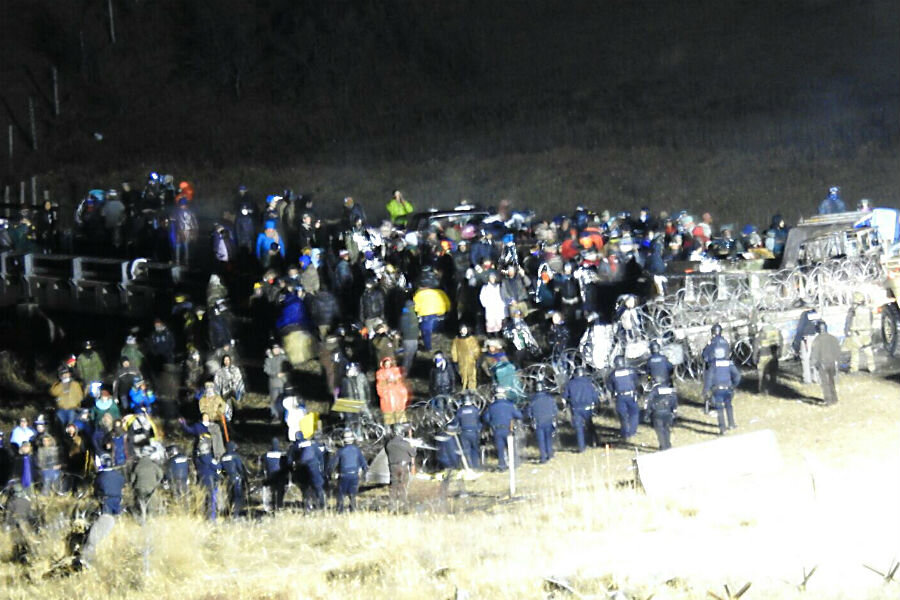Standing Rock protest area to be closed by Army Corps of Engineers
Loading...
| Bismarck, N.D.
The chairman of the Standing Rock Sioux tribe said Friday that the U.S. Army Corps of Engineers plans to close an area where people have been camping for months to protest the Dakota Access oil pipeline.
Dave Archambault said in a statement that he received a letter from the Corps, dated Friday, which says all lands north of the Cannonball River will be closed Dec. 5.
"The letter states that the lands will be closed to public access for safety concerns," Archambault said.
Representatives from the Army Corps of Engineers didn't immediately return messages Friday seeking comment and verification of the letter.
The letter, provided by the tribe, says: "To be clear, this means that no member of the general public, to include Dakota Access pipeline protesters, can be on these Corps lands."
It says anyone on land north of the river after Dec. 5 will be trespassing and may be prosecuted. It also says anyone who stays on the land does so at his or her own risk.
The letter, from Army Corps of Engineers Col. John Henderson, says the closure is necessary to protect the general public from violent confrontations between protesters and authorities and to protect demonstrators from illness, injury or death during North Dakota's harsh winter months. It also says that the area does not have necessary first responder services or facilities to protect people during the winter.
A free speech zone will be set up south of the river.
Archambault said the land to be closed includes the Oceti Sakowin camp, a sprawling encampment on Army Corps land about 50 miles south of Bismarck. For months, opponents of the four-state, $3.8 billion pipeline have been camping in the area to protest the pipeline.
Some of the protests have resulted in violent confrontations and hundreds of arrests. A clash earlier this week near the main protest camp left a police officer and several protesters injured, including Sophia Wilansky, who suffered a serious arm injury and is in satisfactory condition in a Minneapolis hospital.
The Standing Rock and Cheyenne River Sioux tribes are fighting the Dakota Access project because they fear it will harm drinking water and cultural sites. Pipeline developer Energy Transfer Partners disputes that and says the 1,200-mile pipeline through the Dakotas, Iowa and Illinois will be safe.
The pipeline is nearly complete outside of a stretch beneath a Missouri River reservoir in southern North Dakota, just to the north of the Standing Rock reservation.
"Our Tribe is deeply disappointed in this decision by the United States, but our resolve to protect our water is stronger than ever," he said. He's asking pipeline opponents to continue to fight the pipeline's permitting process.
Meanwhile, the leader of the Cheyenne River Sioux in South Dakota called for pipeline opponents to boycott businesses in North Dakota's capital, a move Bismarck's city administrator says is uncalled for and disappointing.
The Cheyenne River Sioux Tribal Council voted in September to not spend money in Bismarck and neighboring Mandan, and Chairman Harold Frazier at the time called on all tribal members to join the effort. Earlier this week, he sought to broaden the boycott to make a statement against what he calls "heavy-handed, illegal and violent oppression" of people who have protested against the pipeline for months.
Bismarck City Administrator Keith Hunke said Friday the boycott is disappointing given that the city's businesses aren't involved in the dispute. He said no businesses have reported an impact from boycotts and protest activity in the area is inconvenient, but hasn't cut into business's bottom lines.
"We've had some of our streets blocked for a period of time, but generally after a period of time the protesters disband and business gets back to normal," he said.
More than 560 protesters have been arrested since August in the Bismarck-Mandan area and at the main protest camp, including more than 30 at a Bismarck mall on Friday — one of the busiest days of the year. Police said protesters gathered for a prayer at Kirkwood Mall, and some refused to leave the entrance to a Target store when ordered.
__
Forliti reported from Minneapolis. Follow her on Twitter at: http://www.twitter.com/amyforliti.







